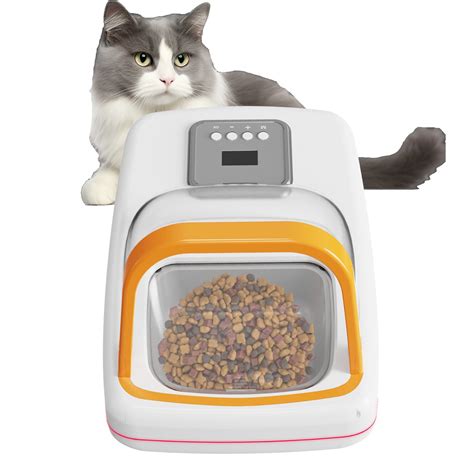Introduction
In the realm of pet care, technology has revolutionized the way we feed and monitor our furry companions. RFID pet feeders, with their advanced capabilities, offer a convenient and efficient solution for ensuring your pet’s nutritional well-being. However, before making the switch, it’s essential to delve into the pros and cons of RFID pet feeders versus traditional feeding methods.

RFID Pet Feeders: The Cutting Edge
RFID (Radio Frequency Identification) pet feeders utilize radio waves to identify an authorized pet and dispense a predetermined amount of food. This innovative approach offers several advantages:
-
Portion Control: RFID pet feeders precisely measure and dispense food, preventing overfeeding and promoting optimal weight management.
-
Automated Feeding: Program these feeders to dispense food at specific times, ensuring your pet is fed regularly, even when you’re away.
-
Pet Recognition: RFID tags attached to your pet’s collar allow the feeder to identify authorized animals, preventing unauthorized access.
-
Feeding Reminders: Many RFID pet feeders include feeding reminders, alerting you when it’s time to refill the feeder or check the pet’s food intake.
Traditional Pet Feeders: Simple and Practical
Traditional pet feeders are simple and provide basic functionality:
-
Manual Feeding: These feeders require manual filling and dispensing of food, offering less precision and convenience.
-
Limited Features: Traditional feeders lack automated feeding capabilities and feeding reminders, requiring more attention and effort from pet owners.
-
No Pet Recognition: Traditional feeders allow any pet to access the food, which can lead to overfeeding or conflict in multi-pet households.
Comparative Analysis: RFID VS Traditional
To facilitate a comprehensive understanding of these feeding methods, a comparative analysis is presented:
| Feature | RFID Pet Feeders | Traditional Pet Feeders |
|---|---|---|
| Portion Control | Precise and automatic | Manual and less precise |
| Automated Feeding | Scheduled feeding | Manual feeding |
| Pet Recognition | Authorized pet only | All pets can access |
| Feeding Reminders | Available | Not available |
| Convenience | High | Moderate |
| Price | Higher | Lower |
RFID Pet Feeders in 2025 and Beyond: Future Trends
The future of RFID pet feeders is bright, with advancements on the horizon:
-
Integration with Smart Home Systems: RFID pet feeders will seamlessly integrate with smart home systems, allowing remote monitoring and control.
-
Health Tracking: RFID pet feeders will incorporate sensors to monitor pet activity and food intake, providing valuable insights into their overall health.
-
Personalized Feeding Plans: RFID pet feeders will utilize AI algorithms to tailor feeding plans to each pet’s individual needs.
Effective Strategies for Implementing RFID Pet Feeders
To maximize the benefits of RFID pet feeders, consider these strategies:
-
Start Gradually: Introduce the RFID feeder gradually to avoid confusing your pet.
-
Establish a Routine: Program the feeder for regular feeding times to establish a consistent routine.
-
Monitor Food Intake: Regularly check the feeder’s records to ensure your pet is consuming an appropriate amount of food.
-
Keep the Feeder Clean: Maintain the feeder regularly to prevent any malfunction or hygiene issues.
Tips and Tricks for Troubleshooting
If you encounter any challenges with your RFID pet feeder, try these tricks:
-
Check the RFID Tag: Ensure the RFID tag on your pet’s collar is functioning correctly.
-
Reset the Feeder: If the feeder is malfunctioning, try resetting it to its default settings.
-
Contact the Manufacturer: If the issue persists, don’t hesitate to reach out to the manufacturer for assistance.
FAQs: Addressing Common Concerns
1. How often should I clean my RFID pet feeder?
Regular cleaning is recommended, at least once per month, to prevent food accumulation and hygiene issues.
2. My pet is not responding to the RFID tag. What should I do?
Check the tag for proper attachment and functionality. If the issue persists, contact the manufacturer.
3. Can I use the RFID pet feeder for multiple pets?
Yes, many RFID pet feeders allow for multiple pet recognition, enabling you to feed different pets with customized portions.
4. How much does an RFID pet feeder cost?
RFID pet feeders vary in price depending on features and brand, typically ranging from $50 to $200.
5. Are RFID pet feeders safe for my pet?
Yes, RFID technology is generally considered safe and does not emit harmful radiation.
6. How do I choose the right RFID pet feeder for my needs?
Consider your pet’s feeding habits, the number of pets, and the features you desire when selecting an RFID pet feeder.
Conclusion
RFID pet feeders revolutionize pet feeding by providing precision, convenience, and peace of mind. While traditional feeders offer a basic solution, RFID feeders deliver advanced capabilities that enhance pet care. By carefully evaluating the comparative advantages and implementing effective strategies, pet owners can make an informed choice that best suits their needs. As technology continues to evolve, RFID pet feeders will undoubtedly play an increasingly significant role in shaping the future of pet feeding.





















